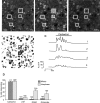Purinergic and muscarinic modulation of the cell cycle and calcium signaling in the chick retinal ventricular zone
- PMID: 12196580
- PMCID: PMC6757998
- DOI: 10.1523/JNEUROSCI.22-17-07569.2002
Purinergic and muscarinic modulation of the cell cycle and calcium signaling in the chick retinal ventricular zone
Abstract
Spontaneous calcium transients occur in the ventricular zone of the chick retina and result from the endogenous release of neurotransmitters in the absence of action potentials. Calcium transients resulting from the activation of purinergic and muscarinic receptors occur in a mixed population of interphase and mitotic cells, whereas those produced by ionotropic GABA and glutamate receptors are mostly restricted to the interphase population, the GABA responses primarily coming from cells that express the neuronal marker TuJ-1. Muscarinic and purinergic receptors can act respectively as a brake and an accelerator on mitosis, whereas GABA and glutamate receptors are without effect. Our results suggest that the balance between muscarinic and purinergic activation acts to control the rate of retinal proliferation in early development.
Figures









Similar articles
-
Hippocampal astrocytes in situ exhibit calcium oscillations that occur independent of neuronal activity.J Neurophysiol. 2002 Jan;87(1):528-37. doi: 10.1152/jn.00268.2001. J Neurophysiol. 2002. PMID: 11784768
-
Ca2+ responses to ATP via purinoceptors in the early embryonic chick retina.J Physiol. 1996 Jun 15;493 ( Pt 3)(Pt 3):855-63. doi: 10.1113/jphysiol.1996.sp021428. J Physiol. 1996. PMID: 8799905 Free PMC article.
-
Calcium signaling to nucleus via store-operated system during cell cycle in retinal neuroepithelium.Neurosci Res. 2003 Apr;45(4):447-58. doi: 10.1016/s0168-0102(03)00004-x. Neurosci Res. 2003. PMID: 12657458
-
Muscarinic regulation of Ca2+ signaling in mammalian atrial and ventricular myocardium.Eur J Pharmacol. 1999 Jun 30;375(1-3):177-96. doi: 10.1016/s0014-2999(99)00231-9. Eur J Pharmacol. 1999. PMID: 10443574 Review.
-
Control of cell proliferation by neurotransmitters in the developing vertebrate retina.Brain Res. 2008 Feb 4;1192:37-60. doi: 10.1016/j.brainres.2007.04.076. Epub 2007 May 6. Brain Res. 2008. PMID: 17597590 Review.
Cited by
-
Imaging of cAMP levels and protein kinase A activity reveals that retinal waves drive oscillations in second-messenger cascades.J Neurosci. 2006 Dec 6;26(49):12807-15. doi: 10.1523/JNEUROSCI.3238-06.2006. J Neurosci. 2006. PMID: 17151284 Free PMC article.
-
Gap junctions modulate interkinetic nuclear movement in retinal progenitor cells.J Neurosci. 2005 Nov 16;25(46):10803-14. doi: 10.1523/JNEUROSCI.2312-05.2005. J Neurosci. 2005. PMID: 16291954 Free PMC article.
-
Human Müller glia with stem cell characteristics differentiate into retinal ganglion cell (RGC) precursors in vitro and partially restore RGC function in vivo following transplantation.Stem Cells Transl Med. 2012 Mar;1(3):188-99. doi: 10.5966/sctm.2011-0005. Epub 2012 Mar 7. Stem Cells Transl Med. 2012. PMID: 23197778 Free PMC article.
-
Adenine Nucleotides Control Proliferation In Vivo of Rat Retinal Progenitors by P2Y1 Receptor.Mol Neurobiol. 2017 Sep;54(7):5142-5155. doi: 10.1007/s12035-016-0059-0. Epub 2016 Aug 24. Mol Neurobiol. 2017. PMID: 27558237
-
Regulation of cellular function by connexin hemichannels.Int J Biochem Mol Biol. 2011;2(2):119-128. Epub 2011 Feb 28. Int J Biochem Mol Biol. 2011. PMID: 21968837 Free PMC article.
References
-
- Antonopoulos J, Pappas IS, Parnavelas JG. Activation of the GABAA receptor inhibits the proliferative effects of bFGF in cortical progenitor cells. Eur J Neurosci. 1997;9:291–298. - PubMed
-
- Baumgold J, Dyer K. Muscarinic receptor-mediated inhibition of mitogenesis via a protein kinase C-independent mechanism in M1-transfected A9L cells. Cell Signal. 1994;6:103–108. - PubMed
-
- Catsicas M, Bonness V, Becker D, Mobbs P. Spontaneous Ca2+ transients and their transmission in the developing chick retina. Curr Biol. 1998;8:283–286. - PubMed
-
- Ciapa B, Pesando D, Wilding M, Whitaker M.Cell-cycle calcium transients driven by cyclic changes in inositol trisphosphate levels. Nature 3681994875–878.0 - PubMed
Publication types
MeSH terms
Substances
Grants and funding
LinkOut - more resources
Full Text Sources
